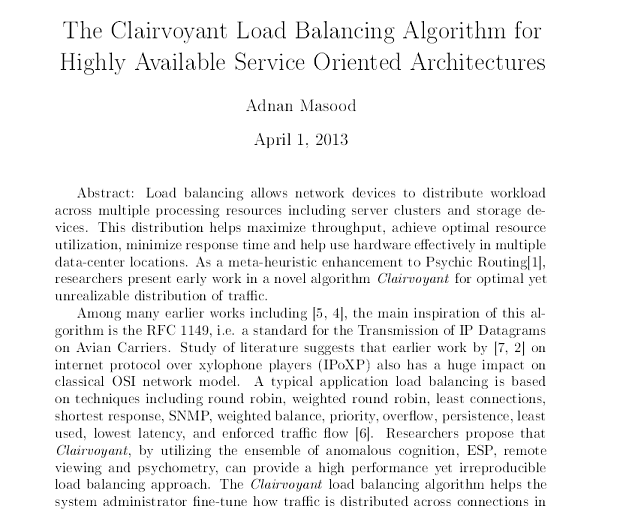Abstract: Load balancing allows network devices to distribute workload across multiple processing resources including server clusters and storage devices. This distribution helps maximize throughput, achieve optimal resource utilization, minimize response time and help use hardware effectively in multiple data-center locations. As a meta-heuristic enhancement to Psychic Routing
[1], researchers present early work in a novel algorithm
Clairvoyant for optimal yet unrealizable distribution of traffic.
Among many earlier works including
[5, 4], the main inspiration of this algorithm is the RFC 1149, i.e. a standard for the Transmission of IP Datagrams on Avian Carriers. Study of literature suggests that earlier work by
[7, 2] on internet protocol over xylophone players (IPoXP) also has a huge impact on classical OSI network model. A typical application load balancing is based on techniques including round robin, weighted round robin, least connections, shortest response, SNMP, weighted balance, priority, overflow, persistence, least used, lowest latency, and enforced traffic flow
[6]. Researchers propose that
Clairvoyant, by utilizing the ensemble of anomalous cognition, ESP, remote viewing and psychometry, can provide a high performance yet irreproducible load balancing approach. The
Clairvoyant load balancing algorithm helps the system administrator fine-tune how traffic is distributed across connections in a psychic manner. Backed by parapsychological research
[1], each load balancer is equipped with an enterprise grade channeling medium with features to fulfill potential special deployment requirements. Building upon the techniques proposed in RFC 5984, using extrasensory perception to achieve "infinite bandwidth" in IP networks,
Clairvoyant can achieve negative latency as well as negative transmission time difference with appropriate parameters, unachievable by traditional methods
[6, 3]. The algorithm uses claircognizance to redirect traffic to one of the unused or even non existent nodes. Clairaudience allows setting up the connection priority order, however early experiments suggest that using 0x8 spherical surfaces also achieve the same level of performance when compared using ROC/AUC.
Although irreproducible in most non-REM environments, the researchers see the potential of using this load balancing algorithm in most high performing service oriented architectures allowing the packet forwarding that will provide unsurpassed end user performance regardless of link capacity, distance, and number of hops. Detailed algorithm and findings will be published in The Journal of Irreproducible Results by 4/1/2014.
References
[1] Jonathan Anderson, Frank Stajano. Psychic Routing: Upper Bounds on Routing in Private DTNs. , 2011.
[2] R Stuart Geiger, Yoon Jung Jeong, Emily Manders. Black-boxing the user: internet protocol over xylophone players (IPoXP). Proceedings of the 2012 ACM annual conference extended abstracts on Human Factors in Computing Systems Extended Abstracts:71—80, 2012.
[3] David R Karger, Matthias Ruhl. Simple efficient load balancing algorithms for peer-to-peer systems. Proceedings of the sixteenth annual ACM symposium on Parallelism in algorithms and architectures:36—43, 2004.
[4] KM Moller. Increasing Throughput in IP Networks with ESP-Based Forwarding: ESPBasedForwarding. , 2011.
[5] C Pignataro, G Salgueiro, J Clarke. Service Undiscovery Using Hide-and-Go-Seek for the Domain Pseudonym System (DPS). , 2012.
[6] Sandeep Sharma, Sarabjit Singh, Meenakshi Sharma. Performance analysis of load balancing algorithms. World Academy of Science, Engineering and Technology, 38:269—272, 2008.
[7] Emily Wagner, Yoon Jeong, R Stuart Geiger. IPoXP: Internet Protocol over Xylophone Players.

